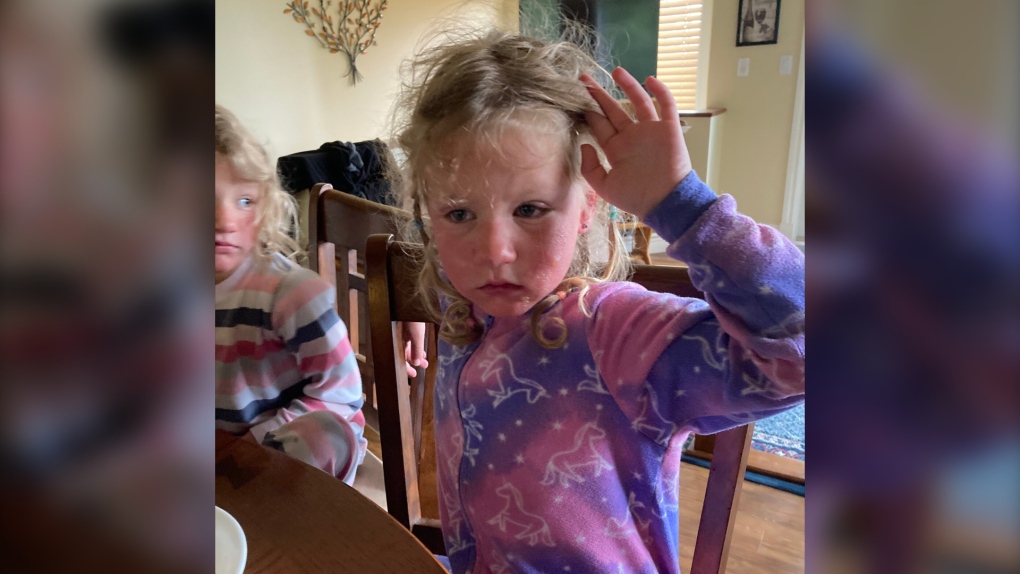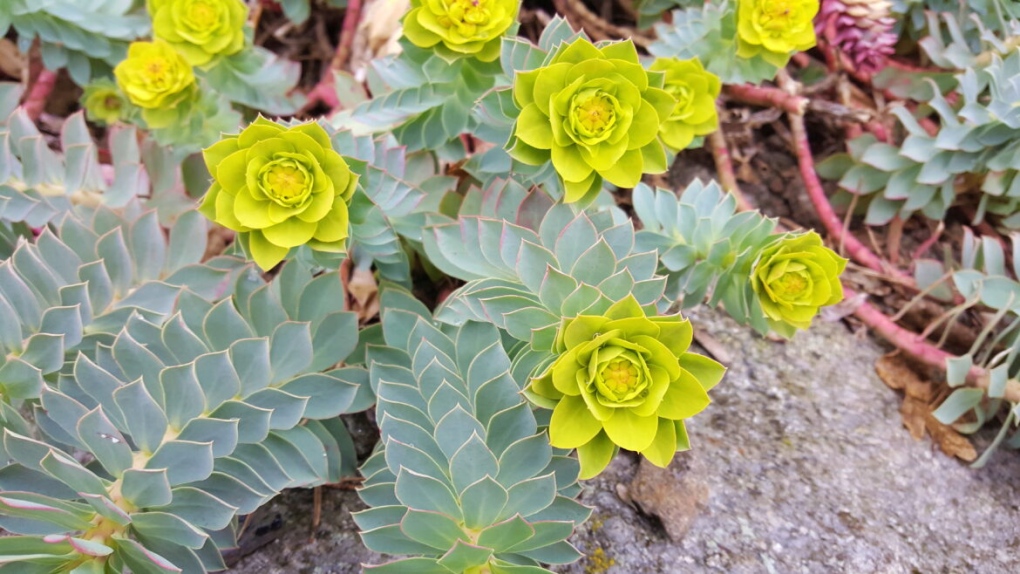Myrtle spurge: B.C. children left burned by invasive plant
 Two children suffering from the effects of Myrtle spurge contact are seen in an image from the Invasive Species Council of B.C.
Two children suffering from the effects of Myrtle spurge contact are seen in an image from the Invasive Species Council of B.C.
The Invasive Species Council of B.C. is asking the public to report sightings of a "highly toxic" plant that can leave people's skin blistered and burned – something one family recently learned the hard way.
Okanagan residents Doug and Sandra Nimmo were hosting their granddaughters over the July long weekend when the children came into contact with Myrtle spurge, a garden perennial that carries a nasty sap capable of causing blindness in severe cases.
Fortunately, the children, who had been picking plants for a bouquet, only woke up the next morning with red and irritated skin, according to the Invasive Species Council, which shared the family's story.
"They got out of bed, and I was shocked to see their faces puffed up with blisters," Sandra Nimmo told the ISCBC, adding that the children weren’t seriously hurt.
“They laughed when they saw their faces in the mirror, and it only took about a week and a half to clear their skin.”
Myrtle spurge, or euphorbia myrsinites, is described as an extremely aggressive invasive species from the Mediterranean that can quickly take over gardens and other green spaces.
If ingested, the plant can cause nausea, vomiting and diarrhea. To cause blindness, the sap has to come into contact with someone's eyes.
The Invasive Species Council said Myrtle spurge is recognizable by its small, yellow flowers and light blue-green leaves, which are sharp and spiral closely around the stem. The plant grows 10 to 15 cm tall and forms a "low, spreading mound," according to the ISCBC.
 Myrtle spurge is seen in an image from the Invasive Species Council of B.C.
Myrtle spurge is seen in an image from the Invasive Species Council of B.C.
The plants are mostly found in the Okanagan, where they thrive in its warm climate and dry soil. They’re also sometimes found for sale at garden centres, despite being provincially regulated.
"With our PlantWise program, we are working with growers, retailers, and consumers to spread the word about which invasive species shouldn’t be sold and grown in B.C.," ISCBC's Allison McCabe said in a statement. "Great alternatives to Myrtle spurge include Lanceleaf Stonecrop (sedum lanceolatum), a beautiful native succulent that thrives in hot, dry conditions.”
The Invasive Species Council of B.C. said people can find more alternatives through its Grow Me Instead website. Anyone who has been in contact with Myrtle spurge or another invasive species is urged to report it online.
CTVNews.ca Top Stories

'They needed people inside Air Canada:' Police announce arrests in Pearson gold heist
Police say one former and one current employee of Air Canada are among the nine suspects that are facing charges in connection with the gold heist at Pearson International Airport last year.
Why drivers in Eastern Canada could see big gas price spikes, and other Canadians won't
Drivers in Eastern Canada face a big increase in gas prices because of various factors, especially the higher cost of the summer blend, industry analysts say.
Customers disappointed after email listing $60K Tim Hortons prize sent in error
Several Tim Horton’s customers are feeling great disappointment after being told by the company that an email stating they won a boat worth nearly $60,000 was sent in error.
Toronto Raptors player Jontay Porter banned from NBA
Toronto Raptors player Jontay Porter has been handed a lifetime ban from The National Basketball Association (NBA) following an investigation which found he disclosed confidential information to sports bettors, the league says.
As GC Strategies partner is admonished by MPs, RCMP confirms search warrant executed
The RCMP confirmed Wednesday it had executed a search warrant at an address registered to GC Strategies. This development comes as MPs are enacting an extraordinary, rarely used parliamentary power, summoning one of its contractors to appear before the House of Commons to be admonished publicly for failing to answer questions related to the ArriveCan app.
Woman who pressured boyfriend to kill his ex in 2000s granted absences from prison
A woman who pressured her boyfriend into killing his teenage ex more than a decade ago will be allowed to leave prison for weeks at a time.
Attempt to have murder charge quashed against alleged serial killer dismissed by judge
A motion filed by the man accused of killing four Indigenous women in Winnipeg to have one of those murder charges quashed has been dismissed by the judge – weeks before the start of his trial.
Government proposes new policy for federally regulated employees to disconnect from work
In their 2024 budget, the federal government wants to amend the Canada Labour Code, so employers in federally regulated sectors will eliminate work-related communication with employees outside of scheduled hours. If implemented, this would affect roughly 500,000 across the country.
Earthquake jolts southern Japan
An earthquake with a preliminary magnitude of 6.4 hit southern Japan late on Wednesday, said the Japan Meteorological Agency, without issuing a tsunami warning.































